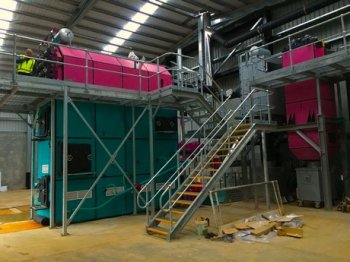
The company reports that it keeps a close watch on the latest international advancements in plant production technology and displays its commitment to best practice through continuous investment in high-tech machinery, systems improvement and highly qualified people. As a result, Zealandia has implemented energy technology never seen before in the country or the industry.
Nearly three years ago, it commissioned its first two Polytechnik advanced biomass energy plants at its Christchurch site and now it’s finishing a third plant in Auckland coupled with a 1000m3 heat storage tank and a closed district heating network with eight independently controlled zones including concrete propagation floor heating, liftable overhead heating, and heating of staff work areas.
Plants 1 and 2 are 1600kW and 2500kW, respectively, with a third 1200kW plant now ready for commissioning. A fourth plant is already in the pipeline with the infrastructure set up to accommodate it.
The energy production process begins by tipping the waste biomass into a concrete fuel bunker. From there, a series of hydraulic rams shuffle the material into the furnace and onto the step grate. With the help of more hydraulics, a water-cooled grate, primary, secondary and induction fans, as well as electronic monitoring of temperatures, pressures and levels, the energy extraction commences. The combustion process continues through multiple passes of the furnace and heat exchanger, both optimized by computational fluid and thermodynamics.
The performance of the entire process is further increased by an exhaust gas recirculation system, an air preheater, air-cooled furnace jacket, heat exchanger bypass duct and roof space air intake snorkel. Although there are regular maintenance procedures, the day-to-day cleaning and ash removal happens automatically.
A compressed air system provides a high velocity air jet down tubes of both the main heat exchanger and the air preheater when the software deems it necessary. Ash from the air preheater and multi-cyclone grit arrestor is automatically stored in respective waste bins, while furnace ash is deposited in another bin located under the front of the furnace and removed with a small gantry crane. Due to the efficient combustion and uncontaminated source fuel, the ash levels are on the order of 2-3% of fuel input and bin emptying is infrequent.
The system is designed to handle a range of fuel sizes in order to allow greater fuel flexibility to the owners. By having greater fuel flexibility, lower cost biomass can be sourced from a wider range of providers.
Unlike the fossil fuel alternative, this offers protection from rising fuel costs by having diversity in supply. Though the exact fuel specification is more in depth, it basically states that the system can handle natural timber and woody biomass residues. These residues can be made up of chips, bark and a percentage of sawdust. Strings of bark up to 600mm and wood chips up to 350mm maximum length can all be accepted as a fractional quantity.
The exceptionally significant aspect of the system is in its ability to handle high moisture content biomass up to 60% without a loss of efficiency. High moisture content is a common attribute to low cost biomass and must be catered for if one is to source low cost fuel.
The versatility of this fully automated biomass energy solution allows fuel costs of much less than 50% of what other energy plants in the region consume. With three combustion zones, back-end gas temperatures of 125 to 140°C, automatic cleaning and de-ashing systems and the million litre heat storage tank, the Zealandia plants are currently considered the most advanced and efficient heat plants in New Zealand for low calorific value biomass.
The emissions of the new plant are fractional when compared to many other projects in the industry. The advanced control system and visualization (including furnace cameras) allows worldwide operators to dial into and optimize the boiler plant 24 hours a day.
Biomass energy derived from plant and animal matter is one of many alternative fuel sources being looked at to replace the fossil fuels that the world relies so heavily on for energy. One of the concepts that make biomass so appealing is that it is a renewable resource, while fossil fuels exist in finite amounts. By investing in this technology, Zealandia has made the choice to move away from fossil fuels, be carbon neutral, responsible and cost efficient.
Source: Sohum Gandhi was integral in the engineering and delivery of the latest project to achieve the energy requirements of Zealandia and a carbon neutral outcome. For further information on this or similar biomass projects, please e-mail.



 Classifieds
Classifieds

